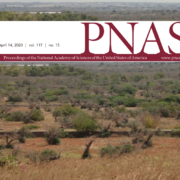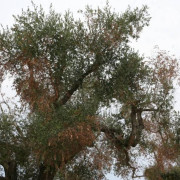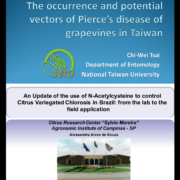Economic impact of Xylella fastidiosa in European olives
The journal PNAS (Proceedings of the National Academy of Sciences of the United States of America) published a study aimed to evaluate the impact of Xylella fastidiosa subspecies pauca in European olives. The study was realized by a multi-national team of scientists and led by economists of the Wageningen University.
In 2013, a strain of Xf-pauca was for the first time detected in the European territory (Italy) causing the Olive Quick Decline Syndrome. The pathogen is spread by insects and the movement of infected plant material, eventually causing the death of infected olive trees. The authors of the study developed a spatially explicit bio-economic model to compute the potential future economic impact of the Xf-pauca threatening the European olive industry. The bio-economic model combined insights from climatic suitability modelling, disease spread simulations and an economic model which computes impact to olive growers in Italy, Greece and Spain. Previous work by EFSA (European Food Safety Authority) on X. fastidiosa directly fed into the disease spread model.
In absence of disease control measures, the bio-economic model indicated that the spread of Xf-pauca could cost billions of Euros over the next 50 years. The findings suggest that most European production sites fall into a climatically suitable territory for the establishment and spread of the disease. In Italy, cessation of production after orchard die-off results in an economic impact of up to 5.2 billion Euro if the pathogen spreads beyond the current extent. Replanting orchards with resistant varieties can lower the impact to 1.6 billion Euro. Reducing the annual rate of spread could save up to 1.3 billion Euro. Introductions into Greece and Spain could result in an impact of up to 2 and 17 billion Euro, respectively. Uncertainty on spread was accounted for by simulating different scenarios. Even under slow disease spread and the ability to replant with resistant cultivars, projections of future economic impact in affected countries run in the billions of Euros.
Currently, there is no practical cure under field conditions. While important research on vector control is ongoing, adaptation through resistant trees seems the most promising long-term strategy. The findings stress the necessity to strengthen the ongoing research on cultivar resistance traits and enforcement of current phytosanitary measures including vector control and inoculum suppression by removing host plants. The study did not account for the cultural heritage value of the European olive trees, many of which are hundreds of years old.
The study was developed within the H2020 Project POnTE.
Link to the article: https://www.pnas.org/content/early/2020/04/07/1912206117









